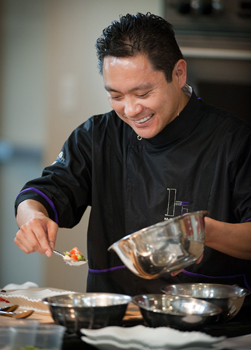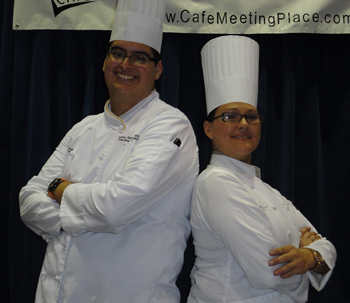Technology in the Toolkit: Connecting Kitchens and Creating Community
Wednesday, 04 September 2013 17:10
 “Gold Medal Classroom” readers who answer a survey (see link below) will receive a special code for a $200 discount on Worlds of Flavor® 2013 registration. Also, all names will be placed into a drawing for one free Worlds of Flavor registration, and three respondents will receive a choice of one of three CIA books.
“Gold Medal Classroom” readers who answer a survey (see link below) will receive a special code for a $200 discount on Worlds of Flavor® 2013 registration. Also, all names will be placed into a drawing for one free Worlds of Flavor registration, and three respondents will receive a choice of one of three CIA books.
By Jan Stuebing Smyth
To be a chef today means to be plugged into local communities, national networks and global conversations. Information technologies are changing foodservice in profound ways in the kitchen, dining room and classroom, particularly since the current generation of Millennial diners grew up with an unprecedented access to 24/7 connectivity.
Any curriculum for aspiring culinarians that does not include a nod to technology in the kitchen—from immersion circulators for new cooking techniques to tablets for access to their curriculum—is incomplete. A single YouTube video, real-time webcast or even an Instagram photo can transport a chef or student to a restaurant or village kitchen thousands of miles away and alter his or her culinary aspirations in an instant, turning the world into a classroom.
Culinary philosophies are being incubated in highly personal, globally conscious ways that could only happen in this hyper-connected age of information and social-networking technologies. Chefs in Spain look to the kitchens of Japan as part of re-imagining their regional traditions. Chefs from New York to California exchange ideas over the web as they re-invent Moroccan and Southeast Asian flavors. Chefs from Lima and Lisbon, Sydney and Shanghai gather at international conferences—like MAD in Copenhagen, Mesamérica in Mexico City and Worlds of Flavor in Napa Valley—to forge new professional bonds that expand the creative space in which they work.
Whereas previously, influential food critics at city and national publications controlled the destiny of ambitious chefs and restaurants, chefs today can build their own communities of support. A four-star review from The New York Times or a top Michelin rating still yields considerable weight in a restaurant’s ability to attract and retain customers, but they are no longer the only game in town. Crowd-sourced reviews from Yelp, Zagat and others, along with social media juggernauts like Twitter and Facebook and the commenting sections of blogs, have undercut the established critics who used to have the power to make or break a restaurant. Not having to court the favor of high-profile critics means not having to skew one’s cooking or dining concepts to the expectations of a small handful of gatekeepers.

 Culinary instructors from across the nation recently participated in Emmi Roth USA culinary-externship program and American Cheese Society conference events.
Culinary instructors from across the nation recently participated in Emmi Roth USA culinary-externship program and American Cheese Society conference events. At the 9th-annual CAFÉ Leadership Conference, four educators earned recognition and professional development for unleashing creativity in the culinary classroom.
At the 9th-annual CAFÉ Leadership Conference, four educators earned recognition and professional development for unleashing creativity in the culinary classroom. Two students’ winning dishes featuring Mexican avocado were enjoyed by attendees of CAFÉ’s 9th-annual Leadership Conference.
Two students’ winning dishes featuring Mexican avocado were enjoyed by attendees of CAFÉ’s 9th-annual Leadership Conference.